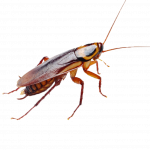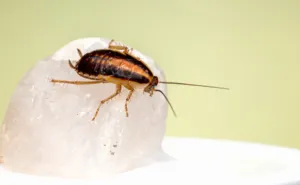Spring is coming again! But: as the temperatures rise and the days get longer, not only people become more active, but cockroaches as well. Many households and businesses find that they suddenly have to deal with these unwanted invaders more often in spring. But why are cockroaches so active in spring? And most importantly, how do you prevent them from invading your home? In this blog, we’ll tell you everything you want to know about why cockroaches become more active in spring, how they invade your home and how to effectively prevent and control cockroaches.
Why do cockroaches become more active in the spring?
Cockroaches are cold-blooded insects and adapt their activity to temperature. In winter, they are less active, but as soon as the temperature rises above 20°C, they become more active.
3 reasons why cockroaches are more likely to enter your home during spring:
- Higher temperatures – Cockroaches are heat lovers. In heated buildings, they can live year-round, but in the spring and summer their population grows explosively.
- More moisture – Cockroaches need moisture to survive. Spring brings rain and higher humidity, making them more active.
- Reproductive season – Cockroaches reproduce at lightning speed. In spring, a female can lay up to 50 eggs at a time, which hatch within a few weeks.
How do cockroaches live?
Cockroaches are nocturnal animals and avoid light as much as possible. They hide during the day and emerge at night to find food and water.
Life cycle of a cockroach
Most cockroaches go through three stages in their lives:
- Egg – A female cockroach lays her eggs in a protective capsule (ootheca).
- Nymph – After a few weeks, the nymphs hatch. They are small and translucent, but grow quickly.
- Adult cockroach – After several molts, they reach their adult size and can reproduce.
An adult cockroach lives an average of 6 to 12 months, but during that time they can produce hundreds of offspring!
Which cockroaches are most common in the Netherlands?
Three species of cockroaches are mainly found in the Netherlands:
- German cockroach (Blattella germanica)
- The most common species in the Netherlands.
- Small (1.1 – 1.6 cm in size), light brown with two dark stripes on the back.
- Likes warm and humid places, such as kitchens and bathrooms.
- Oriental cockroach (Blatta orientalis)
- Dark brown to black, larger than the German cockroach (2 – 3 cm in size).
- Moves slower and lives more often in crawl spaces, basements and drains.
- American cockroach (Periplaneta americana)
- The largest of the three (up to 4 cm in size!), reddish-brown in color.
- Can fly and is mostly found in warehouses and large buildings.
Why are cockroaches dangerous in the home?
Cockroaches in your home are not only dirty, they can also be harmful to your health.
- Cockroaches spread diseases
Cockroaches live in garbage cans, sewers and drains and carry bacteria and viruses. They can transmit diseases such as:
- Salmonella – Can cause food poisoning and intestinal problems.
- E. coli – Can cause severe gastrointestinal problems.
- Dysentery – A severe form of diarrhea caused by bacteria.
- Cockroaches cause allergies and asthma
Cockroaches’ feces, dander and saliva contain allergens that can aggravate asthma and allergies in humans. Children and people with respiratory problems are especially susceptible.
- Cockroaches contaminate food and surfaces
Cockroaches leave bacteria on food, cookware and kitchen cabinets. This can cause food poisoning and other health problems.
What damage can cockroaches do?

In house:
- They destroy food supplies by walking over them and leaving droppings.
- Can they damage electronic devices by settling into hot motors.
- Do they dirty carpets and furniture by their droppings and scent trails.
In companies:
- Hospitality establishments can risk fines or closures for cockroach problems.
- Storage areas and warehouses can become contaminated, rendering products unusable.
- A cockroach infestation can damage a company’s image and deter customers.
So having cockroaches in your home or business is not only dirty, but also a serious health risk and can cause a lot of damage. That is why it is important to control cockroaches in your home as soon as possible!
Where do cockroaches enter your home?
Cockroaches are masters at finding small openings and dark hiding places. They can enter your home through:
- Cracks and tears in walls, floors and baseboards. Even an opening as small as 3 millimeters is big enough for a cockroach!
- Drains and sewers, especially in older buildings. The German cockroach (Blattella germanica) is known to enter homes through drains.
- Vents and air vents. Poorly sealed ventilation systems can provide an ideal passageway for cockroaches.
- Groceries or packaging. Did you just get a box of bananas from the supermarket? Tropical cockroaches can hide in packaging materials.
- Neighbors: Do you live in an apartment complex? If so, cockroaches can easily move from home to home through pipes and walls.
Because cockroaches are active at night and hide well, you often don’t notice their presence until the problem is already worse. That’s why it’s smart to take preventive measures.
Read more information on how to recognize a cockroach infestation here .
How do you prevent cockroaches in your home?
The best weapon against cockroaches is preventing them from entering your home. Here are the most effective prevention methods:
- Keep your house clean
- Clean up food scraps immediately and vacuum regularly.
- Store food in sealed containers and keep the kitchen clean.
- Make sure the trash can is tightly sealed and empty it regularly.
- Close off all possible inputs
- Seal cracks and gaps in walls, baseboards and floors.
- Place grilles over vents and drains.
- Check used furniture before you bring it into your home.
- Avoid damp areas
- Repair leaking faucets and pipes.
- Ventilate damp areas such as bathrooms and basements.
- Dry sinks and countertops before bedtime.
- Use natural repellents
Want to chase away cockroaches without chemicals? Then try these natural methods:
- Peppermint oil or lavender oil – Soak cotton pads and place them on suspicious spots.
- Baking soda and sugar – Mix these substances and sprinkle them on areas where cockroaches hide.
- Laurel or cedarwood – Put this in kitchen cabinets, as cockroaches hate the smell.
- Use professional pesticides when necessary
- When an infestation begins, you can use special cockroach traps or insect sprays. Note: Do not use standard bug spray, as it only kills visible cockroaches. Rather, choose decoys with poison so they take the substance to their hiding place
What to do if you do have cockroaches in your home?
Do you still have cockroaches in your home despite all preventive measures? Then quick action is needed:
- Place decoy boxes or traps to check how big the problem is.
- Use professional pesticides such as poison or special sprays.
- Call in a professional pest controller in the event of a serious infestation.
At OFS Services, we are happy to help you control cockroaches in your home effectively and safely. Contact us for a quick and professional solution!


